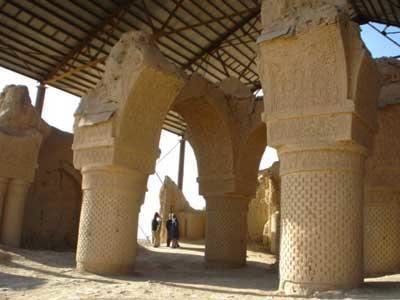Type ruin | ||
 | ||
Aramgah e Qazi Yunus (Persian: آرامگاه قاضى يونس, now known as Hajji Piadah Baba ḤĀJI PIĀDA pilgrimage to Mecca on foot) is the tomb of the Prophet Yunus.
Contents
The tomb is on the edge of the Masjid e No Gonbad (Persian: مسجد نُهگنبد Mosque of Nine Cupolas), a Samanid-style building in Balkh province of northern Afghanistan.
The site was listed on the World Monuments Fund's 2006 World Monuments Watch list of 100 Most Endangered Sites.
History
It was built in the 9th century, it is thought to be the earliest Islamic building in the country.
In the Sassanid Dynasty the Akashdadah e Naubahar (Persian: آتشکده نوبهار Fire Temple of Naubahar) was located there. In the Kushan Empire it was a common meditation center, with Barmarkiden ornaments featuring expanded Hindu, Buddhist and Zoroastrian patterns (Mithra cult like sun, flowers, lily) which were painted over with plaster during the Samanid conquest.
Nine domes were added making it the first mosque in Bactra. As the hidden ornaments were discovered, they were destroyed in deference to Islamic religious considerations. The grave of Judge Yunus does not fit into the complex.
Tomb
The tomb measures 20×20 meters. The outside walls are of mud-brick construction. The interior is divided into nine bays, each originally covered by a dome. The columns and the arches that divide the bays are decorated in deeply carved stucco, depicting a wide variety of designs, stylistically comparable to Abbasid decoration in Mesopotamia.
